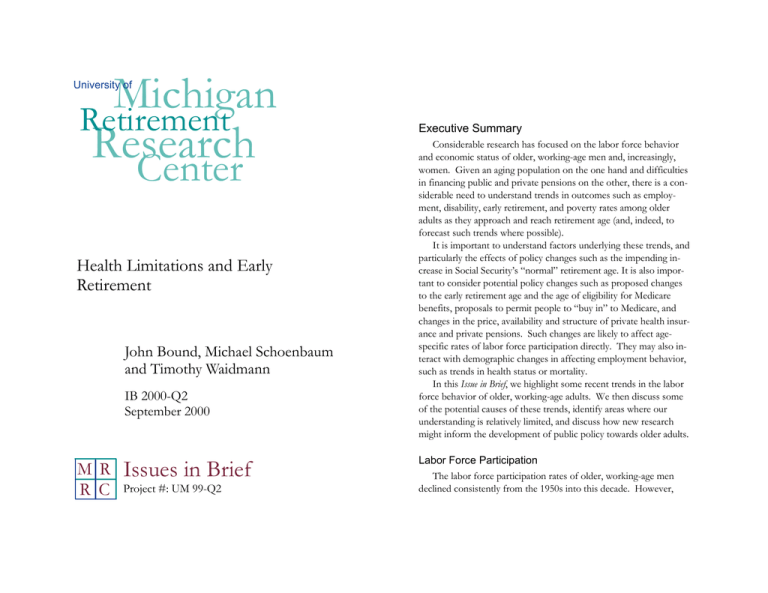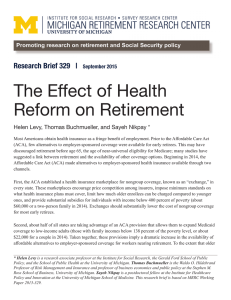Research Michigan Center Retirement
advertisement

Michigan Retirement Research University of Executive Summary Center Health Limitations and Early Retirement John Bound, Michael Schoenbaum and Timothy Waidmann IB 2000-Q2 September 2000 M R R C Issues in Brief Project #: UM 99-Q2 Considerable research has focused on the labor force behavior and economic status of older, working-age men and, increasingly, women. Given an aging population on the one hand and difficulties in financing public and private pensions on the other, there is a considerable need to understand trends in outcomes such as employment, disability, early retirement, and poverty rates among older adults as they approach and reach retirement age (and, indeed, to forecast such trends where possible). It is important to understand factors underlying these trends, and particularly the effects of policy changes such as the impending increase in Social Security’s “normal” retirement age. It is also important to consider potential policy changes such as proposed changes to the early retirement age and the age of eligibility for Medicare benefits, proposals to permit people to “buy in” to Medicare, and changes in the price, availability and structure of private health insurance and private pensions. Such changes are likely to affect agespecific rates of labor force participation directly. They may also interact with demographic changes in affecting employment behavior, such as trends in health status or mortality. In this Issue in Brief, we highlight some recent trends in the labor force behavior of older, working-age adults. We then discuss some of the potential causes of these trends, identify areas where our understanding is relatively limited, and discuss how new research might inform the development of public policy towards older adults. Labor Force Participation The labor force participation rates of older, working-age men declined consistently from the 1950s into this decade. However, Health Limitations and Early… 1 data from the Current Population Survey suggest that participation rates stabilized during the 1990s among men aged 55-64, and have actually increased slightly in the last several years (e.g., increasing from 65.5% in 1993 to 68.1% in 2001; Bureau of Labor Statistics, various years). Participation rates for older, working-age women have consistently increased over the same period, including during the 1990s. An extensive literature has sought to explain declines in labor force participation among men, focusing on factors such as the incentive effects of public and private pensions as well as income maintenance programs like Social Security Disability Insurance and trends in labor demand. The recent upswing in male labor force participation at older ages may reflect changes in labor supply and/or demand. The elimination of mandatory retirement changes in the Social Security Retirement Program and changes in the structure and coverage of private pensions all probably contributed to the recent increase in the labor force attachment of older workers. Similarly, the relatively strong economy over most of the last decade is likely to have increased the demand for older workers. At the same time, however, labor force participation rates among older, working-age people with health problems have been declining through the 1990s. As a result, the gap in participation between the disabled and non-disabled is growing. Increases in the availability of Social Security Disability Insurance (DI) benefits that occurred during the late 1980s and 1990s appear to have contributed to these trends, although some have argued that the Americans for Disability Act has worked to discourage employers from hiring disabled workers during the same period. Health and Disability Changes in labor force participation rates may also reflect trends in health status. Recent studies have suggested that functional status among people beyond retirement age has been improving. Although little research exists on trends in the health of older, working-age people, it is possible that their health status has also been improving, with associated increases in labor supply. For instance, the rate of DI awards based on limitations due to cardiovascular disease has fallen substantially over the last two decades. On the other hand, awards based on mental health limitations, particularly affective disorders, rose dramatically over the same period of time, largely due to changes in the mental health listings used in the evaluation of DI applicants. In addition, since disability reflects an interaction between individuals' physical capacity and the demands of their environment, it is possible that rates of disability have changed due to trends in occupational patterns (e.g., a shift from manufacturing to service), in employers’ willingness or ability to accommodate workers’ physical limitations, and/or in medical technology that improves functioning among people with limitations. To date, little research exists on the possible effects of trends in health status or trends in the work environment on labor force participation rates. More generally, although health is clearly an important determinant of labor force behavior, little is currently known about why individuals respond differently to the onset of a health problem. Differences in the labor force behavior of individuals who appear, to researchers, to be in comparable health could be due to a number of factors, including actual, unobserved differences in health; differences in economic resources; the demands of individuals’ jobs, as well as the behavior of their employers and coworkers; and differ- Health Limitations and Early… 2 ences in motivation or taste. The absolute and relative importance of these factors is not currently well understood. Our calculations using 1990 Census data indicate that more than half of men and one-third of women who leave the labor force before reaching the Social Security early retirement age of 62 report that health limits their capacity to work. However, given uncertainty in the measurement of health, it may be of interest to assess what people mean by this report. It may also be useful to identify the fraction of those in poor health in their 50s and early 60s who actually leave the labor force, and what choices people make to facilitate continued labor force participation. For instance, while 1990 Census data indicate that the majority of men and women aged 60-61 who identified themselves as having a health-related work limitation were in fact not working – but among those not working, only about half reported receiving Social Security benefits or other public transfer income. We currently know little about the income sources of the other half. At the same time, research has suggested that younger workers who suffer negative health shocks are relatively more likely than older workers to change employers and to continue to work after the onset of a health problem, and that younger workers who leave the labor force are relatively more likely than older workers to apply for DI. Among older working-aged people who do leave the labor force, there is reason to believe that those who report health limitations are very different from those who do not. For instance, our exploratory calculations suggest that those who report health limitations tend to be less well educated and are more likely to be from minority populations; in addition, a much higher share of their income comes from public sources, most importantly DI and Supplemental Security Income (SSI), and a much smaller share comes from either private pensions or asset income. Research on the economic status of older working-aged people in poor health may thus be useful to compare the income sources and economic well-being of those in different states of health and to assess the prevalence of older individuals in poor health who lack the financial resources to retire. Future Research There are a number of areas in which new research could inform the development of public policy towards adults. Based on the issues outlined above, these include: Conducting additional research into trends over time in labor force participation among people with health problems, and in the possible causes for these trends over the last few decades. Overall trends are of interest, but it would also be valuable for research to focus on subgroups that have been particularly affected by policy changes (e.g., those suffering from various chronic health conditions). Assessing the economic well-being of population groups categorized by labor force behavior, health status and participation in public transfer programs. For instance, we can distinguish between those who continue to work, those who leave the labor force but do not apply for DI or SSI, those who apply for DI of SSI benefits but are rejected, and those awarded DI or SSI benefits. What factors determine the category into which an individual will fall? Are there identifiable and substantively important differences in their economic well-being? Examining whether changes in DI and SSI have affected the labor force participation rates and economic well-being of the disabled. For instance, did their economic well-being improve during Health Limitations and Early… 3 the 1970s, when DI and SSI expanded? Did the economic circumstances of people with mental illness improve following the changes in the mental health listings? Identifying whether there are alternative ways to structure disability insurance to correctly target benefits and minimize dead weight loss. Federal disability programs are targeted primarily towards people who are totally disabled. Can this be done accurately? Are there identifiable subgroups of the population whose health limits or prevents their labor force participation but who cannot qualify for public transfer programs? And are there people who are capable of some kind of work who qualify for DI? Identifying policies or programs that might promote continued labor force participation among older, working-age adults whose health declines; and considering the economic efficiency of such efforts. In this context, we also would like to highlight the value to researchers of linking administrative and survey data. For instance, evidence on many of these issues raised above could come from sources such as the Current Population Survey merged with DI and SSI application records. Such merged data have generally not been available to researchers, although they could prove invaluable for informing policy development. Cross-national comparisons could also be of considerable value, with particular focus on countries such as Sweden and Germany that have aggressively attempted to maintain employment levels among the disabled population. John Bound is a Professor of Economics at the University of Michigan. Michael Schoenbaum is with the International Monetary Fund. Timothy A. Waidmann is a Research Associate in the Health Policy Center at the Urban Institute. Michigan Retirement Research Center Institute for Social Research University of Michigan 426 Thompson Street, Room 3026 Ann Arbor, MI 48104-2321 Phone (734) 615-0422 Fax (734) 615-2180 http://www.mrrc.isr.umich.edu mrrc@umich.edu Regents of the University of Michigan David A. Brandon, Ann Arbor Laurence B. Deitch, Bingham Farms Daniel D. Horning, Grand Haven Olivia P. Maynard, Goodrich Rebecca McGowan, Ann Arbor Andrea Fischer Newman, Ann Arbor S. Martin Taylor, Grosse Pointe Farms Katherine E. White, Ann Arbor Mary Sue Coleman, ex officio The Michigan Retirement Research Center is supported by a grant from the Social Security Administration (grant number 10-P-98358-5). Health Limitations and Early… 4




